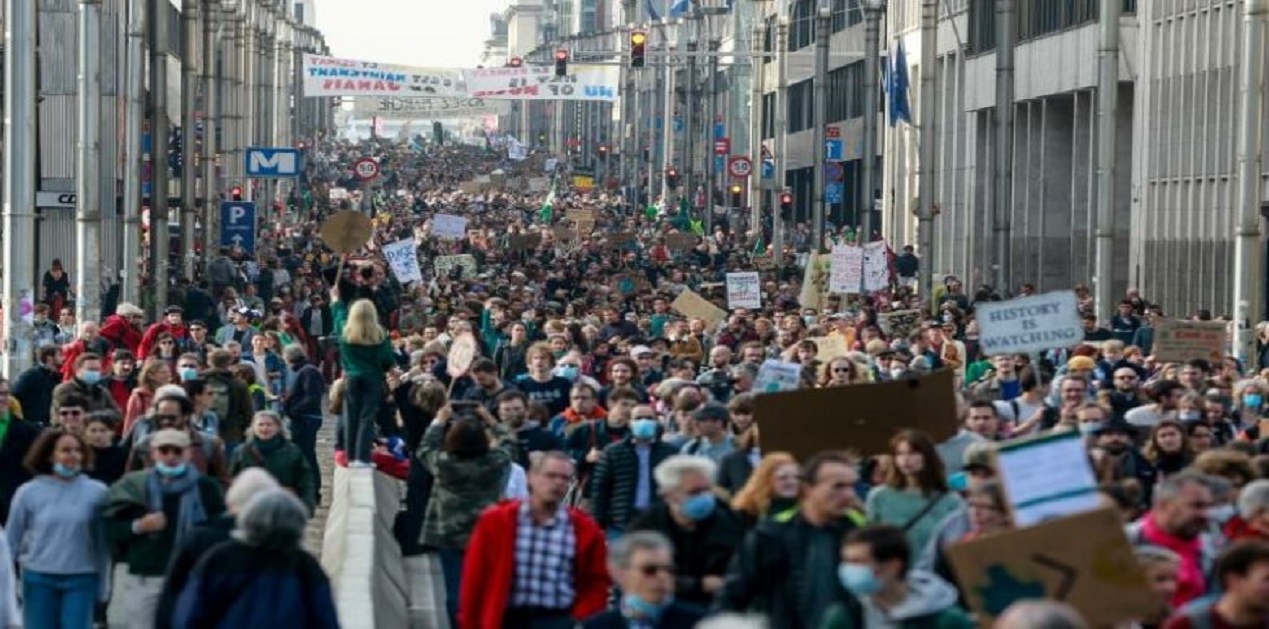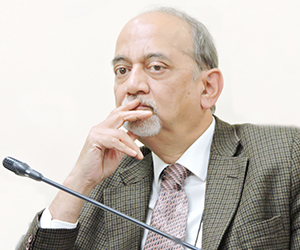The UN Secretary-General Antonio Guterres in his speech to the UN General Assembly described the findings of the report of the Intergovernmental Panel on Climate Change as ‘Code Red for humanity’[1]. He made a call for urgent action. This has been reflected in the statements of most world leaders. There have been calls for Net Zero Emission, though there are varying timelines for reaching this goal. An intermediate goal is peaking of the emissions. The goal of reducing emissions has put a premium on non-fossil fuels. These include apart from the wind and solar, hydropower, and nuclear energy. The report of the International Energy Agency (IEA) has suggested meeting 90 percent of the world’s demand for electricity through non-renewable resources by 2050. Most of the rest is to come from nuclear power. These issues will come up for discussion at COP 26 at Glasgow, which opens on 31st October. Prime Minister Narendra Modi will attend the Summit.
While there are different approaches to the problem of de-carbonization of the economy, nuclear power has a major share in the energy mix of major economies. It is much higher than the case in India. It is part of the US Clean Energy Standard. It is also included in Japan’s Fifth Energy Plan. Nuclear power will remain a major part of the energy mix of the US (20 %), EU (20 %), and China (10%) in the future. [2] This is substantially higher than India, where nuclear power accounts for less than 2 % of generation at present. Japan’s new Prime Minister Fumio Kishida in a debate in the Japanese parliament stated: ‘It’s crucial that we re-start nuclear power plants.’[3] This is despite the historical background of the bombing of Hiroshima and Nagasaki in the Second World War, and the Fukushima accident in 2011.
The debate on energy transition is taking place against the background of the electricity price hike in Europe. This was triggered by the slowing down of winds over the North Sea and an upward trend in gas prices. The worst affected are the UK and Germany, which depend upon wind energy to generate a large part of their power requirements. This has called into question not only UK and German models but also assumptions underlying the IEA report which relies upon a very high share of renewables in the grid. IEA Director has denied that renewables are a factor in the recent electricity price increase in Europe. The World Energy Outlook 2021 brought out by IEA is silent on the ongoing electricity crisis in Europe. But, renewables are an intermittent source of power. When the sun is not shining and the wind is not blowing, they have to be backed by an alternate source of energy. This ‘balancing’ power is supplied by gas in Europe. Ironically, this has created a symbiotic relationship between wind power and fossil fuel. If gas was not a factor in electricity production, the hike in gas prices need not have affected electricity prices.
Gas is also used for heating. But the five-fold increase in electricity price took place in September before the onset of winter. Gas hike has indeed contributed to the sharp increase in electricity price in Europe. But it is not the sole factor triggering the present crisis. The gas prices started rising early this year. Even before this trend began, Germany had the highest electricity tariff in the world. It is closely followed by Denmark. The common element in both cases is that they draw heavily on renewable power. The subsidy burden for renewables reached $ 38 billion in Germany last year.
According to CEA figures, renewables accounted for only 9.2 % of power generation, while coal accounted for 71 % in 2018-19. Clearly, in India’s case, it is imported coal, not renewable, which is threatening power shortage and an increase in prices. India was affected by the trend, which began in China. China has a similar energy profile as India with coal providing for the bulk of generation. An increase in coal prices and a ban on coal imports from Australia triggered the increase in coal prices there. China accounts for 50.5 % of world demand. This is more than four times the Indian share of 11.3 %. [4] The Chinese demand sets the global price trend, which has also affected India.
Nuclear power provides relative insulation from international trends of hikes in the price of imported gas or coal. While India imports uranium, fuel cost has a negligible share in nuclear power generation. It also provides a stable, base-load power. In the case of India, the average tariff from nuclear power plants was Rs. 3.47 per unit in 2019. This is lower than the renewable tariff if the cost of the storage solution is factored in. In recent tenders for renewables with battery solution, Greenco won the contract for Rs. 4.04 per kWh, while Renew Power won the contract for Rs. 4.30 kWh.[5]
While the national experiences in different countries may differ, it is clear that nuclear power combines the advantage of emission-free electricity and offers stable, base-load power. As Bill Gates put it in his book How To Avoid A Climate Disaster, ‘It’s the only carbon-free energy source that can reliably deliver power day and night, through every season, almost anywhere on earth, that has been proven to work on a large scale. No other clean energy source comes even close to what nuclear already provides today.’ [6]
While there is a consensus on climate change, there is no agreement on how to tackle the problem. The total carbon budget available is part of the global commons. However, the concept of Net Zero Emission leaves the implementation to individual member states. Each country has to reach the level where its emissions are balanced by the absorption or sink it provides. This ostensibly places developed and developing countries on the same footing. However, this ignores the historical responsibility of developed countries, which have exhausted 80 percent of the carbon budget. As their per capita emissions widely vary, this means that developed countries will continue to appropriate a much larger share of the remaining carbon budget in the future also.
The EU is using a market mechanism to limit carbon emission by the industry by pricing carbon. There is a strong move in the EU to impose a carbon tax on imports from other countries, which either do not have such a regime or where the level of the carbon tax is lower. This is justified on the ground that this is required to avoid carbon leakage, where companies will try to get around the tax at home by shifting production overseas. The European Commission has proposed a Carbon Border Trade Mechanism. [7]This would amount to imposing environment conditionalities on trade in violation of WTO rule. The EU countries are likely to push for an international regime for a carbon tax in COP 26 at Glasgow. This is essentially a protectionist move. If accepted, it will raise the cost of domestic industry. India already has the coal of Rs. 400 per ton. However, the carbon price in Europe is much higher. It is currently trading at Euro 57.78 per tonne.[8]
The outcome of COP 26 may be uncertain. But the growing pressure to reduce emissions cannot be denied and will continue beyond the Glasgow conference. India is well on track to achieve its commitments under Paris Conference. However, there is a need to do more in terms of afforestation. India had made a commitment to creating an ‘additional carbon sink’ of 2.5 to 3 billion tonnes of CO2 by 2030. So far we achieved only 81 million tonnes. We need to do more. There is also a need to do more in terms of adaptation measures. Schemes like MNREGA and National Rural Livelihoods Mission can be used to enhance adaptation works.
There will be demand for showing more ‘ambition’ at Glasgow. Quite independently of international trends, we need a clean environment. India has to make its energy choices carefully. Nuclear power provides an ideal way to harmonize our climate goals with energy security at home. This however requires policy intervention by the Government. Unlike other areas, the nuclear sector is not yet open to private investment. Therefore, the expansion of this sector cannot draw resources from the stock exchange or capital markets. The resources for ramping up the nuclear sector will have to be provided by the government. Nuclear power also needs ‘must-run’ status on par with renewables. Like in the case of the US, UK, France, and a host of other countries, nuclear power should be recognized as part of India’s energy-mix to move towards a low carbon economy.
End Notes
[1]https://www.un.org/press/en/2021/sgsm20847.doc.htm, accessed on 26.9.2021, 11.39 pm
[2]VIF Task Force Report, Nuclear Power: Imperative for India’s Development, Page 16
[3]Asia Pacific, Japan’s new PM defends pro-nuclear stance in parliamentary debut’, 11th October 2021
[4] (Source: WorldOMeter, https://www.worldometers.info/coal/coal-consumption-by-country/)
[5]https://asian-power.com/regulation/in-focus/indias-renewable-plus-storage-tariffs-beat-new-thermal-costs
[6]How To Avoid A Climate Disaster by Bill Gates, page 84
[7]https://ec.europa.eu/commission/presscorner/detail/en/qanda_21_3661
[8]https://ember-climate.org/data/carbon-price-viewer/
(The paper is the author’s individual scholastic articulation. The author certifies that the article/paper is original in content, unpublished and it has not been submitted for publication/web upload elsewhere, and that the facts and figures quoted are duly referenced, as needed, and are believed to be correct). (The paper does not necessarily represent the organisational stance... More >>
Image Source: https://www.laprensalatina.com/thousands-protesters-call-for-action-to-curb-climate-change-in-brussels/











Post new comment